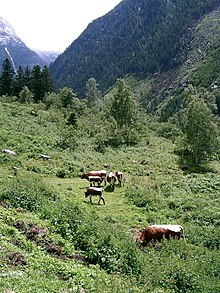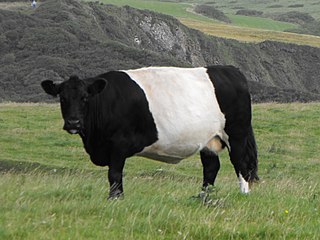
The Lakenvelder is a Dutch and German breed of dairy cattle. It is reported from the Netherlands and Belgium, but may be extinct in Germany.

The Toggenburger or Toggenburg is a Swiss breed of dairy goat. Its name derives from that of the Toggenburg region of the Canton of St. Gallen, where it is thought to have originated. It is among the most productive breeds of dairy goat and is distributed world-wide, in about fifty countries in all five inhabited continents.
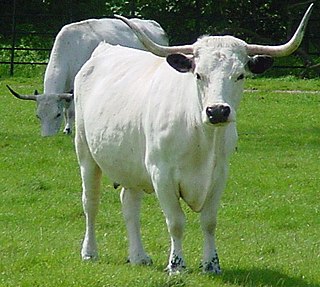
The White Park is a modern British breed of cattle. It was established in 1973 to include several herds or populations of colour-pointed white cattle – white-coated, with points of either red or black on the ears and feet. Such cattle have a long history in the British Isles, and the origins of some herds go back to the Middle Ages.

The Fleckvieh is a breed of dual-purpose cattle suitable for both milk and meat production. It originated in Central Europe in the 19th century from cross-breeding of local stock with Simmental cattle imported from Switzerland. Today, the worldwide population is 41 million animals.
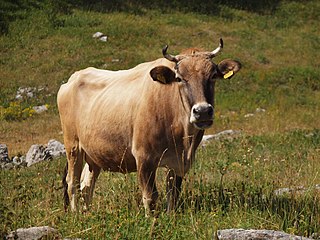
The Buša or Busha is a breed or group of breeds of small short-horned cattle distributed in south-eastern Europe, principally in Albania and the countries of the former Yugoslavia – Bosnia and Herzegovina, Croatia, Kosovo, Macedonia, Montenegro and Serbia. Related breeds include the Gurgucke, Lekbibaj and Prespa of Albania, the Gacko of Bosnia and Herzegovina, the Greek Shorthorn, the Metohija Red of Kosovo and the Rhodope Shorthorn of Bulgaria.

The Karabair is a long-established horse breed from Central Asia, and particularly from Uzbekistan and northern Tajikistan. It results from the cross-breeding of desert horses of Arabian or Turkmene type from the south with steppe horses from the north. It is a small, agile and versatile horse that can be used for riding or driving. It is well suited to local horse sports, and especially to the Uzbek national game, kokpar. It is also used for meat and milk production; the milk may be made into kumis.

The Armoricaine or Armorican is an endangered French breed of domestic cattle. It originated in Brittany in the nineteenth century. It has a red coat with white markings, and has short horns.
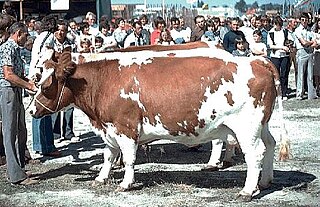
The Pie Rouge des Plaines is a modern French breed of dairy cattle. It was created in about 1970 by cross-breeding the traditional Armorican cattle of Brittany, in north-western France, with red-pied cattle of the Dutch Meuse-Rhine-Yssel and German Deutsche Rotbunte breeds.

The Jezersko–Solčava is a breed of domestic sheep from the eastern Alpine region of Europe. Until the outbreak of the First World War it was the most numerous sheep breed in southern Carinthia, in Friuli and in Slovenia. Its name derives from the regions of Jezersko and of Solčava, formerly in the Austrian Empire, now in Slovenia. It is raised also in parts of Austria, Germany and Italy; a small number were imported to Serbia in 1991. It may also be known as the German: Kärntner Brillenschaf, Seeländer Schaf or Villnösser Schaf.
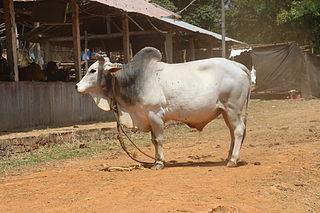
The Malvi or Malavi, also known as Manthani or Mahadeopuri, is breed of zebu cattle from the Malwa plateau in western Madhya Pradesh, in central India. It is a good draught breed; the milk yield of the cows is low.

The Fjäll is a traditional Swedish breed of polled mountain cattle. It was threatened with extinction in the 1970s and 1980s, but recovered after a breed association was formed in 1995, partly thanks to stocks of frozen semen. Microsatellite analysis has shown it to be closely related to the endangered Bohuskulla breed.
The Azerbaijan, is an Azerbaijani breed or group of breeds of riding horse of Oriental type. In 2007 it was listed by the FAO as endangered; in 2021 it was not among the horse breeds reported to DAD-IS.

The Podolica is an Italian breed of domestic cattle. It belongs to the Podolic group of grey cattle. It is raised in the southern Italian regions of Abruzzo, Basilicata, Calabria, Campania, Molise and Puglia. It was formerly distributed throughout most of mainland Italy and as far as Istria, now part of Croatia, and where it is now regarded as a separate breed, the Istrian or Boškarin. The Podolica was in the past bred principally as a draught animal; with the mechanisation of agriculture following the Second World War, demand for draught oxen disappeared, and the Podolica is now raised for meat and – to a lesser extent – for milk.
The Istriana or Carsolina, Croatian: 'Istarska Ovca', Slovene: 'Istrska Pramenka', is a breed of domestic sheep from Istria and the Karst regions of the northern Adriatic, from north-east Italy to Croatia and Slovenia.

The Chamois Coloured Goat, French: Chèvre chamoisée, German: Gämsfarbige Gebirgsziege, Italian: Camosciata delle Alpi, is an indigenous breed of domestic goat from Switzerland. It is distributed throughout Switzerland and in parts of northern Italy and Austria, and has been exported to other countries including France. There are two strains, a horned type from the Grisons or Graubünden in the eastern part of the country, and a hornless type from the former bezirk of Oberhasli and the area of Brienz and Lake Brienz in the Bernese Oberland in central Switzerland. In some countries the hornless variety may be considered a separate breed, the Oberhasli goat. The Swiss herd-book was established in 1930.

The Umblachery is an Indian breed of zebuine cattle. It is distributed in the coastal plains of the districts of Nagapattinam, Tiruvarur and Thanjavur in the state of Tamil Nadu in South India. It was bred for draught work, particularly in the rice paddies of the area.

The Swedish Red-and-White, Swedish: Svensk Röd och Vit Boskap, frequently abbreviated to SRB, is a Swedish breed of dairy cattle. It was created in the 1920s by crossing the Swedish Red Pied and Swedish Ayrshire breeds.
The Swedish Red Pied, Swedish: Rödbrokig Svensk Boskap, frequently abbreviated to RSB, was a Swedish breed of dairy cattle. It is now considered extinct. It was merged in the 1920s with the Swedish Ayrshire breed to create the Swedish Red-and-White, which is one of the principal dairy breeds of Sweden.

The Valdostana Pezzata Rossa is an Italian breed of cattle from Valle d'Aosta region in north-western Italy. It is red-pied, usually with white legs, stomach and face. It is one of three regional breeds in the area, the others being the Valdostana Castana and the Valdostana Pezzata Nera. Like them, it derives from inter-breeding of various local breeds and types of cattle. The most important of these were Swiss Simmental cattle, which came into the Valle d'Aosta over the Great St. Bernard Pass. The Valdostana Pezzata Rossa is a dual-purpose breed, raised mainly for milk, but also for meat. Management is normally transhumant: the cattle are stabled only in winter, and spend the summer months on the mountain pastures of the Alps.
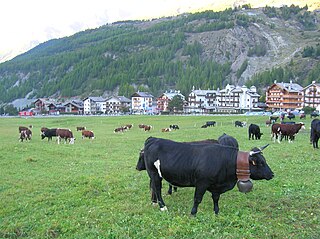
The Valdostana Pezzata Nera is an Italian breed of cattle from Valle d'Aosta region in north-western Italy. It is black-pied, with short horns. It is one of three regional breeds in the area, the others being the Valdostana Castana and the Valdostana Pezzata Rossa. Like them, it derives from inter-breeding of various local breeds and types of cattle. It appears to have been most influenced by the Swiss Fribourgeoise and Hérens breeds, which came into the Valle d'Aosta over the Great St. Bernard Pass. The Valdostana Pezzata Nera is a dual-purpose breed, raised mainly for milk, but also for meat. Management is normally transhumant: the cattle are stabled only in winter, and spend the summer months on the mountain pastures of the Alps.

